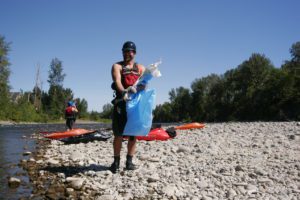FLOAT SAFETY RIVER ETIQUETTE
On the Water Guidelines for a Safe and Fun trip down the Lower Clackamas.
Safety Musts
- Know your conditions/abilities: Check the weather and river conditions, and double check the date: is it going to be a busy day on the river? Is it going to rain or get cold? Look at the interactive map to formulate your plan, and adjust to your abilities and the conditions. Shuttles, parking, loading and unloading, and just getting on the river can be an ordeal. Plan accordingly.
- Communicate – Let someone know that you (and your group) are on the river, and between which access points (which section) you are traveling. This can be as simple as a text, or filing a float plan with a park ranger. Despite being extremely accessible to a large urban population, the Clackamas River is truly ‘wild’ and can be dangerous at any time of the year.
- First Aid – Make sure someone in the group has basic first aid training, carries a phone in a ziplock or water proof bag (or the phone is waterproof), and is completely confident leading a trip on the water. This could be one person or multiple people. And make sure your drivers (other leaders!) secure their keys so they do not end up in the river.
Float Safety Checklist
- PFD with a whistle – at least one whistle for each boat; PFD for everyone (and those under 12 must wear at all times).
- Competent swimmers? – know your limits. The Clackamas has many deep pools and swift currents, even at the lowest levels.
- Know how to self rescue – this includes getting back in/on your boat (or tube!), or swimming to a safe spot on the shore.
- Feet first down the rapids – to push away from rocks), and never stand up in swift current (risk of foot entrapment is high on the Clackamas because of large round rocks on the bottom).
- Protect your feet! The Clackamas is not friendly to bare feet – irregular rocks, thorny plants, and lots of sticks on the beaches in and along the shore)
- Understand the hazards ahead – this is part of ‘know your conditions,’ but specifically know what kind of hazards appear on the section you are floating or paddling. You should anticipate possible strainers (trees in the water), swift currents, and rocky rapids.
 Etiquette Checklist
Etiquette Checklist
- Leave no Trace: pack out all of your own trash (bring your own bags or get a Stash the Trash bag at kiosks near the boat ramps). If you accidently drop or lose trash (and it is swept away), let We Love Clean Rivers know (we will go find it!).
- Put-in and take-outs: be mindful of traffic coming and going at the boat ramps, and avoid lingering (and blocking access).
- Boating Right of Way: upstream boaters always have the right of way. Large boats usually must give way to smaller crafts, but slow moving rafts should be avoided by others just because they cannot maneuver quickly. In general, do not get in the way of other paddlers, fisherfolk, or swimmers and avoid all collisions on the water.
- Spread out – being on the river is a chance to have an authentic outdoor experience and potentially a fun celebration with friends and family. Healthy picnicking and other outdoor gatherings occur on the river – on islands, beaches, and sometimes just in a flotilla. With dozens of islands and beaches (see map!), keep looking for places to spread out and give each other space.
- Courtesy and Friendliness: Be courteous on the river at all times and respectful of other users. If you are able and willing, offer help to others if they ask.
- Respect private property: all land up to the high water line (usually where last year’s floods have left debris) is public and can be used for stopping, rescue, and picnicking. Otherwise, know if you are crossing public or private land (see map).
- Pay all park fees as required and follow park/public land rules
Other things to be mindful of:
- Take a class/obtain the knowledge (see Local Outfitters & guides)
- Be alert for jet boats (they are allowed) coming from upstream or downstream, even at low water.
- Beware of high and cold spring flows from snow melt and rains. Even though it can be 90 degrees outside, the lower Clackamas can be dangerously cold in the spring (50 degrees). It remains comparatively chilly in the summer (60 degrees).
- Review the Gear Checklist/Recommendations to make sure you are properly prepared
- Have a charged cell phone with you in a drybag (or ziplock bag).
- Have a float plan (see Itineraries)
- Set shuttle in advance (see guides and outfitters)
